2022中考英语二轮复习PPT课件过关--语法互动6 形容词和副词
文档属性
| 名称 | 2022中考英语二轮复习PPT课件过关--语法互动6 形容词和副词 | 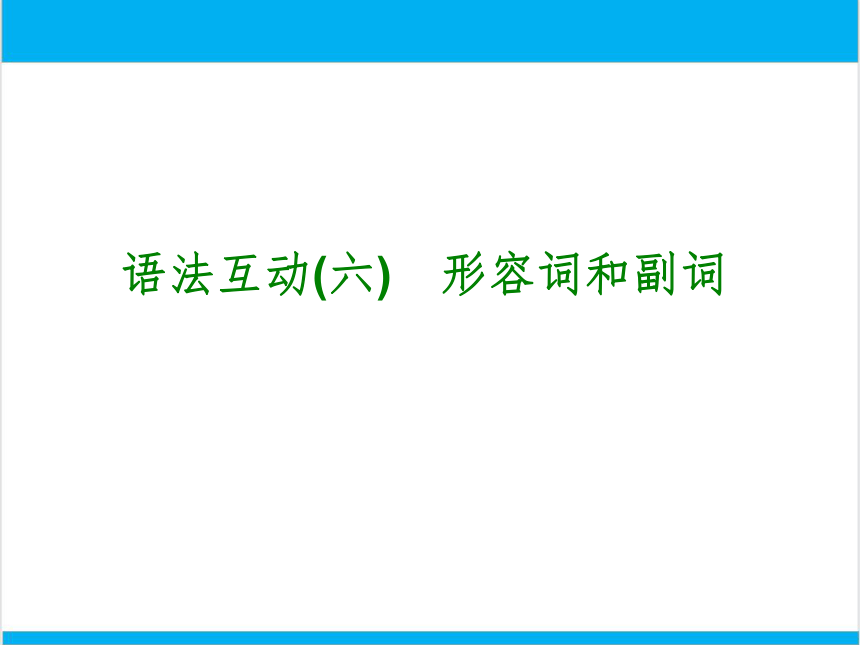 | |
| 格式 | ppt | ||
| 文件大小 | 422.0KB | ||
| 资源类型 | 试卷 | ||
| 版本资源 | 通用版 | ||
| 科目 | 英语 | ||
| 更新时间 | 2022-06-01 15:06:18 | ||
图片预览

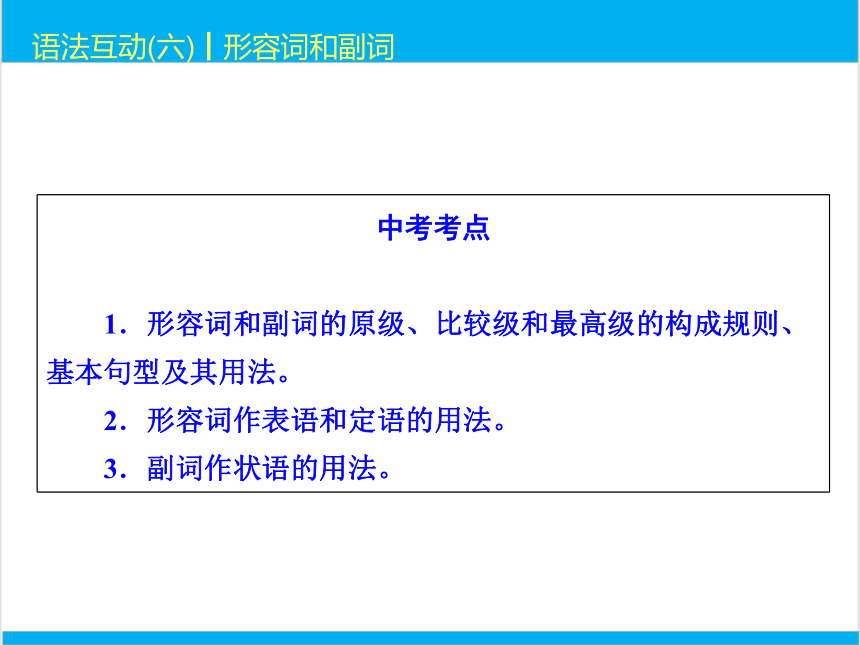
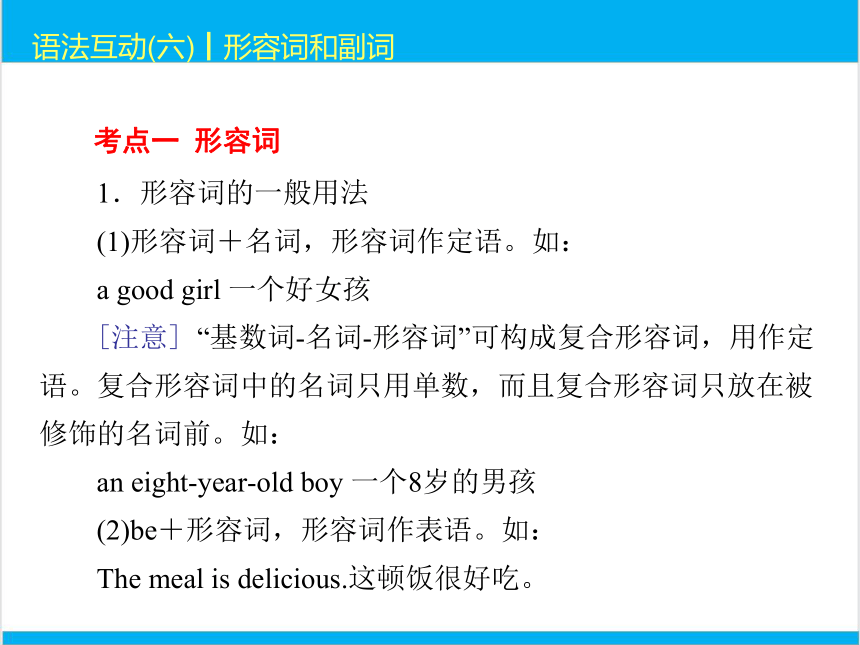

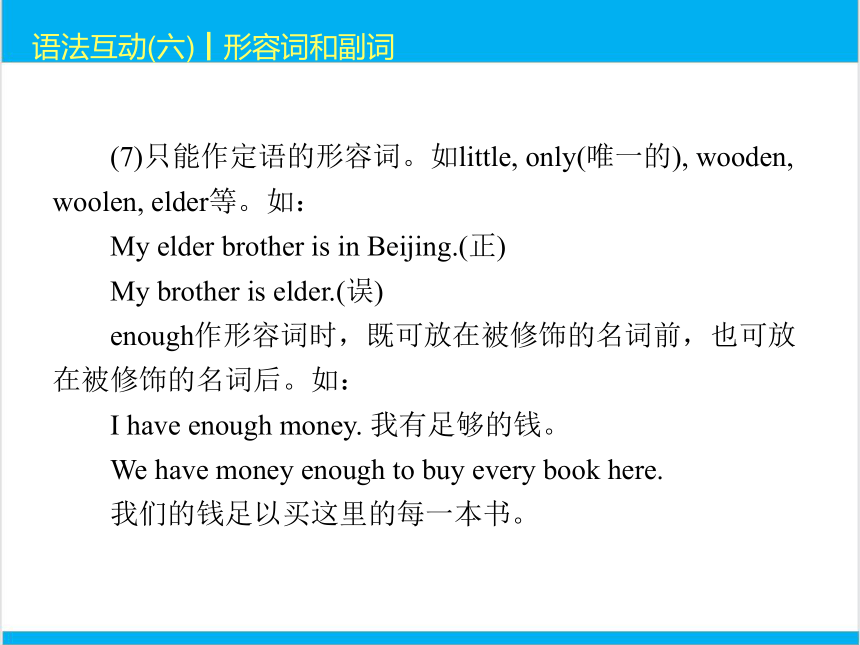
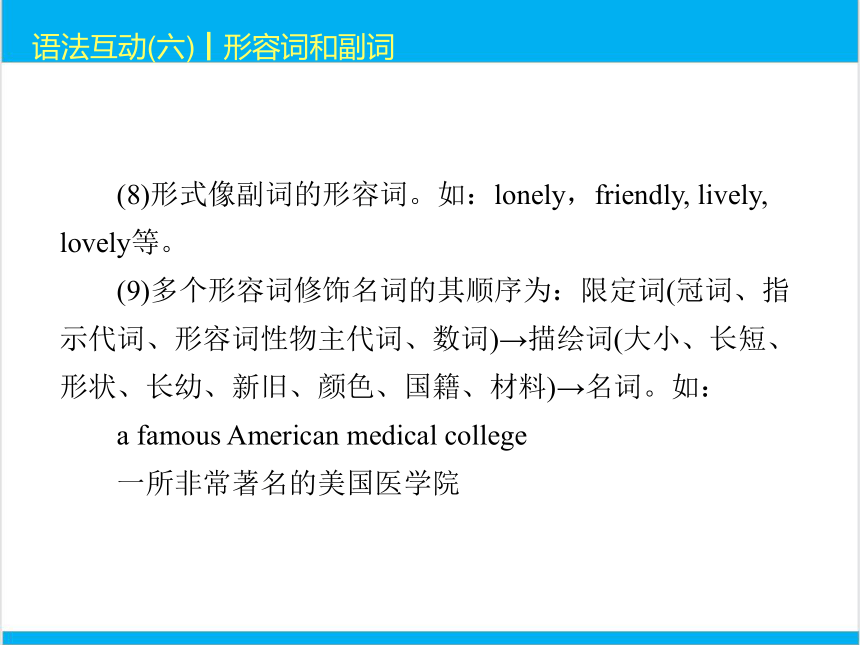
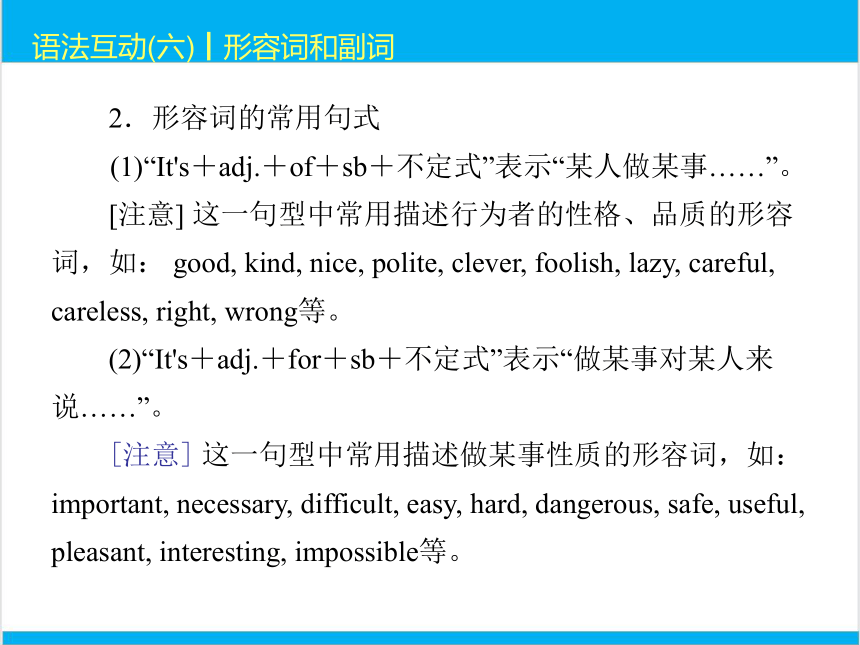
文档简介
(共17张PPT)
语法互动(六) 形容词和副词
中考考点
1.形容词和副词的原级、比较级和最高级的构成规则、基本句型及其用法。
2.形容词作表语和定语的用法。
3.副词作状语的用法。
语法互动(六)┃形容词和副词
1.形容词的一般用法
(1)形容词+名词,形容词作定语。如:
a good girl 一个好女孩
[注意] “基数词 名词 形容词”可构成复合形容词,用作定语。复合形容词中的名词只用单数,而且复合形容词只放在被修饰的名词前。如:
an eight year old boy 一个8岁的男孩
(2)be+形容词,形容词作表语。如:
The meal is delicious.这顿饭很好吃。
语法互动(六)┃形容词和副词
考点一 形容词
(3)不定代词+形容词,形容词作后置定语。如:
______________________重要的事情
(4)数词+形容词,表示长、宽、高、深以及年龄。如:
five thousand kilometers long五千千米长
(5)the+形容词,表示一类人或物。如:
the old 老人
(6)表语形容词。这类形容词只能位于系动词后面作表语。如alone, awake, alive, well(健康的), ill, frightened等。如:
The boy is alone.(正)
The alone boy is here.(误)
something important
语法互动(六)┃形容词和副词
(7)只能作定语的形容词。如little, only(唯一的), wooden, woolen, elder等。如:
My elder brother is in Beijing.(正)
My brother is elder.(误)
enough作形容词时,既可放在被修饰的名词前,也可放在被修饰的名词后。如:
I have enough money. 我有足够的钱。
We have money enough to buy every book here.
我们的钱足以买这里的每一本书。
语法互动(六)┃形容词和副词
(8)形式像副词的形容词。如:lonely,friendly, lively, lovely等。
(9)多个形容词修饰名词的其顺序为:限定词(冠词、指示代词、形容词性物主代词、数词)→描绘词(大小、长短、形状、长幼、新旧、颜色、国籍、材料)→名词。如:
a famous American medical college
一所非常著名的美国医学院
语法互动(六)┃形容词和副词
2.形容词的常用句式
(1)“It's+adj.+of+sb+不定式”表示“某人做某事……”。
[注意] 这一句型中常用描述行为者的性格、品质的形容词,如: good, kind, nice, polite, clever, foolish, lazy, careful, careless, right, wrong等。
(2)“It's+adj.+for+sb+不定式”表示“做某事对某人来说……”。
[注意] 这一句型中常用描述做某事性质的形容词,如:important, necessary, difficult, easy, hard, dangerous, safe, useful, pleasant, interesting, impossible等。
语法互动(六)┃形容词和副词
1.副词的一般用法
(1)用作状语。如:
He speaks English __________. 他英语说得非常好。
(2)用作表语。主要限于少数地点或方位副词、时间副词以及其他副词。如:
I'll be back in five minutes. 我五分钟后就回来。
(3)用作定语。在通常情况下,副词用作定语时总是放在被修饰的名词或代词之后。如:
The people there were very friendly.那儿的人很友好。
2.副词的位置
(1)副词通常放在被修饰的动词后面。
(2)句中有多个助动词时,副词一般放在第一个助动词后。
very well
语法互动(六)┃形容词和副词
考点二 副词
1.形容词用法:系动词+形容词;形容词+名词。如:
He is careful.=He is a __________ boy.
他是个细心的男孩。
2.副词用法:行为动词+副词。如:
He writes __________.
他书写很仔细。
careful
carefully
语法互动(六)┃形容词和副词
考点三 形容词与副词的区分
1.形容词和副词的比较级和最高级的规则变化
(1)一般在词尾直接加-er或-est。如:
tall—taller—tallest, long—________—________
(2)以不发音的字母e结尾的单词在词尾直接加-r或-st。如:
nice—nicer—nicest, large—__________—__________
(3)以“辅音字母+y”结尾的词,把y变为i,再加-er或-est。如:
heavy—heavier—heaviest, busy—busier—busiest
funny—__________—__________
longer
longest
larger
largest
funnier
funniest
语法互动(六)┃形容词和副词
考点四 形容词与副词的三级
(4)在重读闭音节中,若末尾只有一个辅音字母,双写这个辅音字母,再加?er或?est。如:
big—bigger—biggest, hot—hotter—hottest
thin—________—________, fat—fatter—fattest
(5)部分双音节词和多音节词分别在原级前加more构成比较级,加most构成最高级。如:
slowly—__________—__________
beautiful—more beautiful—most beautiful
thinner
thinnest
more slowly
most slowly
语法互动(六)┃形容词和副词
2.形容词和副词的不规则变化
good/well—better—best
many/much—more—most
ill/bad/badly—worse—worst
little—__________—__________
far—farther/further—farthest/furthest
less
least
语法互动(六)┃形容词和副词
3.三级的用法
(1)原级的用法
①只能修饰原级的词有very, quite, so, too等。如:
The old man is __________ walk on.
那个老人太累了以至于不能再继续走了。
②原级常用的句型结构
a.“A+v.+as+形容词原级/副词原级+as B”表示“A和B程度相同”。如:
Lucy is as old as Kate.露西和凯特的年龄一样大。
Tom runs __________ Mike.
汤姆和迈克跑得一样快。
too tired to
as fast as
语法互动(六)┃形容词和副词
b.“ A+v.+not+as/so+形容词原级/副词原级+as B” 表示“A不如B……”。如:
This classroom is ________________ that one.
这间教室不如那间大。
He doesn't walk as slowly as you.
他走路不像你那样慢。
(2)比较级常用的句型结构
①“A+v.+比较级+than+any other+单数名词(+介词短语)”表示“A比同一范围内的任何一个人/物都……”,含义是“A最……”。如:
Xiaoming is taller than ____________ in his class.
=Xiaoming is taller than(any of)the other boys in his class.小明比他班上的其他任何男孩都高。
=Xiaoming is the tallest boy in his class.
小明是他班上最高的男孩。
not as/so big as
any other boy
语法互动(六)┃形容词和副词
②“A+v.+the+比较级+of the two+……”表示“A是两者中较……的”。 如:
Look at the two boys. Xiaoming is __________ the two. 看那两个男孩,小明是两个当中较高的那个。
③“比较级+and+比较级”表示“越来越……”。如:
He is getting ______________.他越来越高了。
He does his homework more and more carefully.
他做作业越来越认真了。
④“the+比较级,the+比较级”表示“越……,就越……”。如:
_________ you work,__________ your grades will be.
你越努力学习,你的成绩就越好。
⑤“特殊疑问词+v.+比较级,A or B?”如:
Which is bigger, the blue ball or the red one
哪一个大,蓝球还是红球?
the taller of
taller and taller
The harder
the better
语法互动(六)┃形容词和副词
[注意] 比较级前常用much, even, a little, a bit, a lot, far等词修饰。
(3)最高级常用句型结构
①“主语+v.+the+最高级+(单数名词)+in/of短语”表示“……是……中最……的”。 如:
Tom is the tallest (student) in his class.
=Tom is the tallest of all the students.
汤姆是他们班上/所有学生当中最高的。
I jump __________ in my class.
我是我们班跳得最远的。
②“主语+v.+one of the+最高级+复数名词+in/of短语”表示“……是……中最……之一”。 如:
Beijing is _____________________________ in China.
北京是中国最大的城市之一。
(the)farthest
one of the biggest cities
语法互动(六)┃形容词和副词
③“特殊疑问词+v.+the+最高级,A,B,or C?”用于三者以上的比较。如:
Which season do you like _______________, spring, summer or autumn
你最喜欢哪一个季节,春天,夏天还是秋天?
④“主语+v.+the+序数词+最高级+单数名词+in/of短语”表示“……是……中的第几……”。如:
Tom is_________________________ boy in his class.
汤姆是他们班第二高的男生。
the second tallest
the second tallest
语法互动(六)┃形容词和副词
语法互动(六) 形容词和副词
中考考点
1.形容词和副词的原级、比较级和最高级的构成规则、基本句型及其用法。
2.形容词作表语和定语的用法。
3.副词作状语的用法。
语法互动(六)┃形容词和副词
1.形容词的一般用法
(1)形容词+名词,形容词作定语。如:
a good girl 一个好女孩
[注意] “基数词 名词 形容词”可构成复合形容词,用作定语。复合形容词中的名词只用单数,而且复合形容词只放在被修饰的名词前。如:
an eight year old boy 一个8岁的男孩
(2)be+形容词,形容词作表语。如:
The meal is delicious.这顿饭很好吃。
语法互动(六)┃形容词和副词
考点一 形容词
(3)不定代词+形容词,形容词作后置定语。如:
______________________重要的事情
(4)数词+形容词,表示长、宽、高、深以及年龄。如:
five thousand kilometers long五千千米长
(5)the+形容词,表示一类人或物。如:
the old 老人
(6)表语形容词。这类形容词只能位于系动词后面作表语。如alone, awake, alive, well(健康的), ill, frightened等。如:
The boy is alone.(正)
The alone boy is here.(误)
something important
语法互动(六)┃形容词和副词
(7)只能作定语的形容词。如little, only(唯一的), wooden, woolen, elder等。如:
My elder brother is in Beijing.(正)
My brother is elder.(误)
enough作形容词时,既可放在被修饰的名词前,也可放在被修饰的名词后。如:
I have enough money. 我有足够的钱。
We have money enough to buy every book here.
我们的钱足以买这里的每一本书。
语法互动(六)┃形容词和副词
(8)形式像副词的形容词。如:lonely,friendly, lively, lovely等。
(9)多个形容词修饰名词的其顺序为:限定词(冠词、指示代词、形容词性物主代词、数词)→描绘词(大小、长短、形状、长幼、新旧、颜色、国籍、材料)→名词。如:
a famous American medical college
一所非常著名的美国医学院
语法互动(六)┃形容词和副词
2.形容词的常用句式
(1)“It's+adj.+of+sb+不定式”表示“某人做某事……”。
[注意] 这一句型中常用描述行为者的性格、品质的形容词,如: good, kind, nice, polite, clever, foolish, lazy, careful, careless, right, wrong等。
(2)“It's+adj.+for+sb+不定式”表示“做某事对某人来说……”。
[注意] 这一句型中常用描述做某事性质的形容词,如:important, necessary, difficult, easy, hard, dangerous, safe, useful, pleasant, interesting, impossible等。
语法互动(六)┃形容词和副词
1.副词的一般用法
(1)用作状语。如:
He speaks English __________. 他英语说得非常好。
(2)用作表语。主要限于少数地点或方位副词、时间副词以及其他副词。如:
I'll be back in five minutes. 我五分钟后就回来。
(3)用作定语。在通常情况下,副词用作定语时总是放在被修饰的名词或代词之后。如:
The people there were very friendly.那儿的人很友好。
2.副词的位置
(1)副词通常放在被修饰的动词后面。
(2)句中有多个助动词时,副词一般放在第一个助动词后。
very well
语法互动(六)┃形容词和副词
考点二 副词
1.形容词用法:系动词+形容词;形容词+名词。如:
He is careful.=He is a __________ boy.
他是个细心的男孩。
2.副词用法:行为动词+副词。如:
He writes __________.
他书写很仔细。
careful
carefully
语法互动(六)┃形容词和副词
考点三 形容词与副词的区分
1.形容词和副词的比较级和最高级的规则变化
(1)一般在词尾直接加-er或-est。如:
tall—taller—tallest, long—________—________
(2)以不发音的字母e结尾的单词在词尾直接加-r或-st。如:
nice—nicer—nicest, large—__________—__________
(3)以“辅音字母+y”结尾的词,把y变为i,再加-er或-est。如:
heavy—heavier—heaviest, busy—busier—busiest
funny—__________—__________
longer
longest
larger
largest
funnier
funniest
语法互动(六)┃形容词和副词
考点四 形容词与副词的三级
(4)在重读闭音节中,若末尾只有一个辅音字母,双写这个辅音字母,再加?er或?est。如:
big—bigger—biggest, hot—hotter—hottest
thin—________—________, fat—fatter—fattest
(5)部分双音节词和多音节词分别在原级前加more构成比较级,加most构成最高级。如:
slowly—__________—__________
beautiful—more beautiful—most beautiful
thinner
thinnest
more slowly
most slowly
语法互动(六)┃形容词和副词
2.形容词和副词的不规则变化
good/well—better—best
many/much—more—most
ill/bad/badly—worse—worst
little—__________—__________
far—farther/further—farthest/furthest
less
least
语法互动(六)┃形容词和副词
3.三级的用法
(1)原级的用法
①只能修饰原级的词有very, quite, so, too等。如:
The old man is __________ walk on.
那个老人太累了以至于不能再继续走了。
②原级常用的句型结构
a.“A+v.+as+形容词原级/副词原级+as B”表示“A和B程度相同”。如:
Lucy is as old as Kate.露西和凯特的年龄一样大。
Tom runs __________ Mike.
汤姆和迈克跑得一样快。
too tired to
as fast as
语法互动(六)┃形容词和副词
b.“ A+v.+not+as/so+形容词原级/副词原级+as B” 表示“A不如B……”。如:
This classroom is ________________ that one.
这间教室不如那间大。
He doesn't walk as slowly as you.
他走路不像你那样慢。
(2)比较级常用的句型结构
①“A+v.+比较级+than+any other+单数名词(+介词短语)”表示“A比同一范围内的任何一个人/物都……”,含义是“A最……”。如:
Xiaoming is taller than ____________ in his class.
=Xiaoming is taller than(any of)the other boys in his class.小明比他班上的其他任何男孩都高。
=Xiaoming is the tallest boy in his class.
小明是他班上最高的男孩。
not as/so big as
any other boy
语法互动(六)┃形容词和副词
②“A+v.+the+比较级+of the two+……”表示“A是两者中较……的”。 如:
Look at the two boys. Xiaoming is __________ the two. 看那两个男孩,小明是两个当中较高的那个。
③“比较级+and+比较级”表示“越来越……”。如:
He is getting ______________.他越来越高了。
He does his homework more and more carefully.
他做作业越来越认真了。
④“the+比较级,the+比较级”表示“越……,就越……”。如:
_________ you work,__________ your grades will be.
你越努力学习,你的成绩就越好。
⑤“特殊疑问词+v.+比较级,A or B?”如:
Which is bigger, the blue ball or the red one
哪一个大,蓝球还是红球?
the taller of
taller and taller
The harder
the better
语法互动(六)┃形容词和副词
[注意] 比较级前常用much, even, a little, a bit, a lot, far等词修饰。
(3)最高级常用句型结构
①“主语+v.+the+最高级+(单数名词)+in/of短语”表示“……是……中最……的”。 如:
Tom is the tallest (student) in his class.
=Tom is the tallest of all the students.
汤姆是他们班上/所有学生当中最高的。
I jump __________ in my class.
我是我们班跳得最远的。
②“主语+v.+one of the+最高级+复数名词+in/of短语”表示“……是……中最……之一”。 如:
Beijing is _____________________________ in China.
北京是中国最大的城市之一。
(the)farthest
one of the biggest cities
语法互动(六)┃形容词和副词
③“特殊疑问词+v.+the+最高级,A,B,or C?”用于三者以上的比较。如:
Which season do you like _______________, spring, summer or autumn
你最喜欢哪一个季节,春天,夏天还是秋天?
④“主语+v.+the+序数词+最高级+单数名词+in/of短语”表示“……是……中的第几……”。如:
Tom is_________________________ boy in his class.
汤姆是他们班第二高的男生。
the second tallest
the second tallest
语法互动(六)┃形容词和副词
同课章节目录
- 词法
- 名词
- 动词和动词短语
- 动词语态
- 动词时态
- 助动词和情态动词
- 非谓语动词
- 冠词
- 代词
- 数词和量词
- 形容词副词及其比较等级
- 介词和介词短语
- 连词和感叹词
- 构词法
- 相似、相近词比较
- 句法
- 陈述句
- 一般疑问句和否定疑问句
- 特殊疑问句及选择疑问句
- 反意疑问句
- 存在句(There be句型)
- 宾语从句
- 定语从句
- 状语从句
- 主谓一致问题
- 简单句
- 并列句
- 复合句
- 主谓一致
- 主、表语从句
- 名词性从句
- 直接引语和间接引语
- 虚拟语气
- 感叹句
- 强调句
- 倒装句
- 祈使句
- 句子的成分
- 句子的分类
- 题型专区
- 单项选择部分
- 易错题
- 完形填空
- 阅读理解
- 词汇练习
- 听说训练
- 句型转换
- 补全对话
- 短文改错
- 翻译
- 书面表达
- 任务型阅读
- 语法填空
- 其他资料
